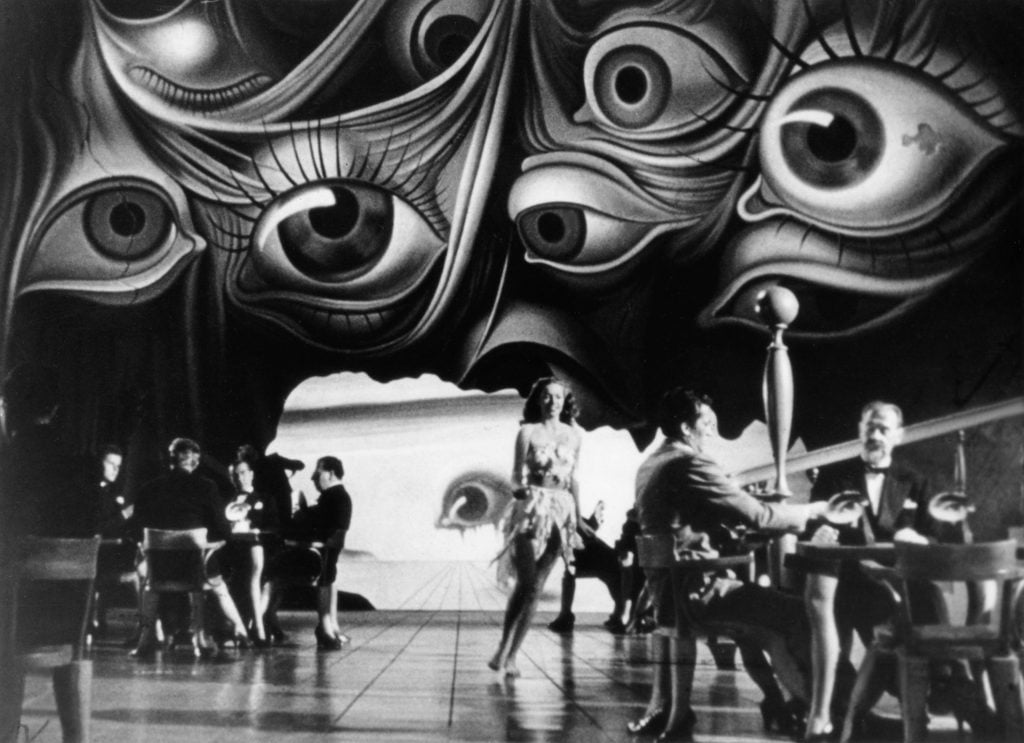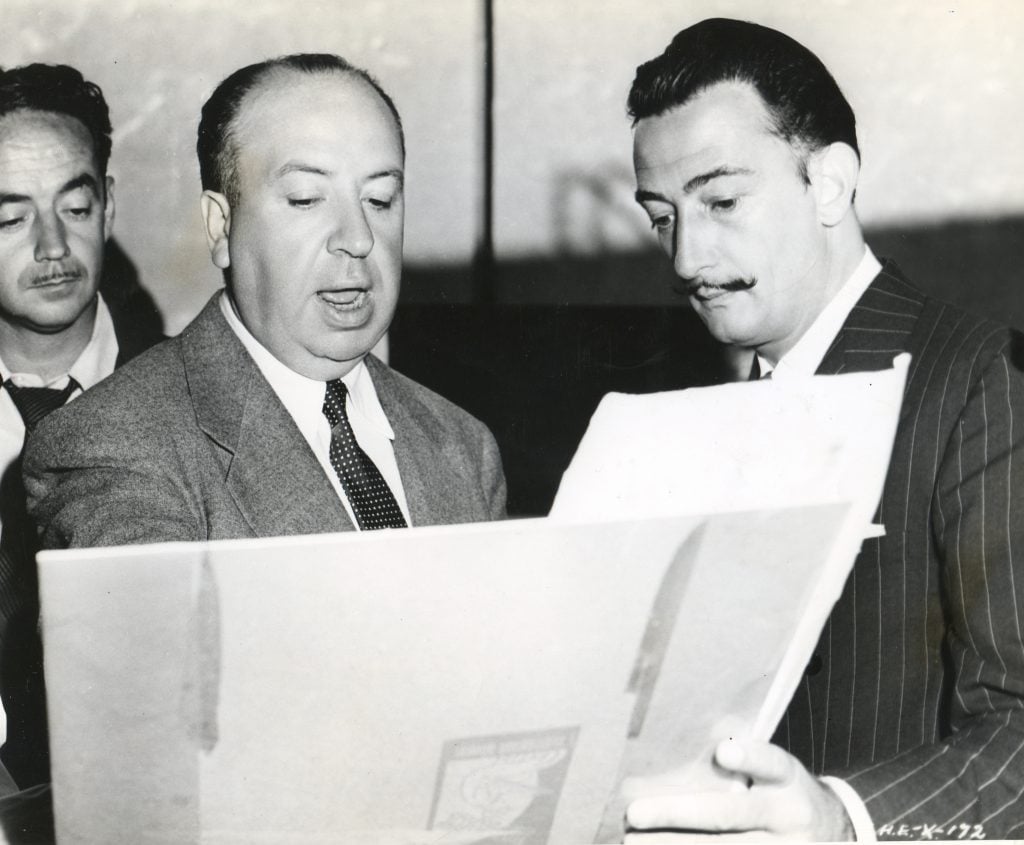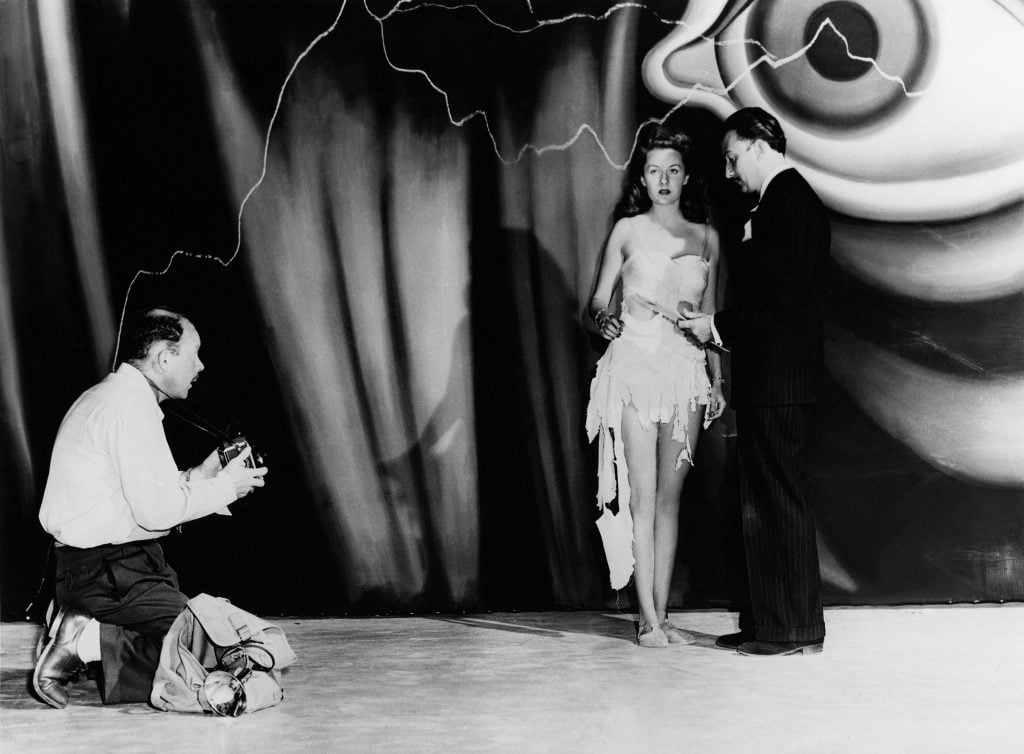Art World
Art Bites: Inside the Feverish Dream Sequence Dalí Concocted for Hitchcock
The director sought out the artist for a surreal scene in 1945's "Spellbound."

To the chagrin of other Surrealists—but the fascination of the general public—Salvador Dalí transcended the art world and entered the realm of the silver screen, transforming him into a bona fide star.
In 1929, Dalí’s infamous film Un Chien Andalou appalled audiences. His second film alongside director Luis Buñuel, the comical L’Age d’Or (1930), was widely rebuked for criticizing the Catholic Church. Dalí and his wife fled Europe for Hollywood in 1940. At first, Dalí dipped his toes into the industry by working on Moon Tide (1942), which was directed by Fritz Lang, but the surrealist’s big Tinsel Town break truly arrived two years later, when Alfred Hitchcock sought him out.

Alfred Hitchcock speaking with Salvador Dalí in 1944. Photo: PhotoQuest/Getty Images.
By then, it had been over a decade since the exiled artist debuted his ubiquitous painting The Persistence of Time (1931). Hitchcock was also well into his career, though some of his most famous films were still decades ahead. Hitchcock was at work on Spellbound (1945), a psychological thriller where a pretty psychoanalyst named Constance Petersen (Ingrid Berman) falls in love with the dreamy new hospital director she works for, Anthony Edwardes (Gregory Peck). Edwardes turns out to be an amnesiac alienated from his true identity—who fears he’s committed murder. Petersen uses her expertise to infiltrate the doctor’s mind, rediscovering his real name and ridding him of guilt for the false crime.
The linear narrative hinges on an illogical dream that Edwardes recounts to Petersen from the couch. Hitchcock, an artist in his own right, habitually thwarted his own clichés. Here, he tapped Dalí for a dream scene that contrasted with the same old hazy filters. “I wanted Dalí because of the architectural sharpness of his work,” Hitchcock said. His sequence would be even sharper than the film itself. Dalí’s experience in photorealism fit the bill, as did the artist’s interest in subconscious psychology, a fashionable, rising field at the time.

Salvador Dalí (right) on the set he created for Spellbound (1945). Photo: United Artist/Selznick international Pictures/Sunset Boulevard/Corbis via Getty Images.
Dalí and Hitchcock collaborated on the sprawling 20-minute scene which started in a gambling house and ended on a distorted rooftop. Many details that Dalí envisioned proved unrealistic—from its 15 suspended grand pianos to a moment where Petersen dissolves into ants. The budget swelled, too, frightening producer David Selznick. Rather than scrapping the film, he hired art director James Basevi to distill Dalí’s vision into a succinct segment they could actually realize. The artist’s credit got demoted, but his style persisted.
Spellbound went on to become a hit. The following year, just before moving back to Europe, Dalí worked with Walt Disney on Destino, an ambitious film stymied by creative conflicts and more budget problems. It was finally released in 2003.
Glimpses of the original Spellbound scene made headlines recently, too, when an interview with Hitchcock’s close friend John Russell Taylor happened upon Dalí’s Spellbound storyboards while perusing San Fernando Valley yard sales during the 1970s. Hitchcock famously joked that he didn’t need to be present to direct, since the important work happened on his storyboards. Hitchcock confirmed to Taylor that the boards were most likely real. His notes alongside Dalí’s masterful designs recounted the movie magic that could have been.
What’s the deal with Leonardo’s harpsichord-viola? Why were Impressionists obsessed with the color purple? Art Bites brings you a surprising fact, lesser-known anecdote, or curious event from art history. These delightful nuggets shed light on the lives of famed artists and decode their practices, while adding new layers of intrigue to celebrated masterpieces.





